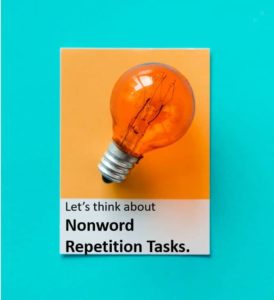After last week’s post on nonword repetition tasks, there were a lot of questions about nonword repetition tasks for Spanish speakers, as well as scoring procedures and interpretation guidelines. Here’s a quick follow-up briefly summarizing some resources. I’ve included the citations below so you can get the nitty gritty details if you need them.

Gutiérrez‐Clellen, V. F., & Simon‐Cereijido, G. (2010). Using nonword repetition tasks for the identification of language impairment in Spanish‐English‐speaking children: Does the language of assessment matter?. Learning Disabilities Research & Practice, 25(1), 48-58.
Gutiérrez-Clellen and Simon-Cerejido ask the question, “Does the language of assessment matter?” Briefly, yes, it does. The authors found that children performed differently on nonword repetition tasks that were based on English rules than they did for nonwords based on Spanish rules.
Ebert, K. D., Kalanek, J., Cordero, K. N., & Kohnert, K. (2008). Spanish nonword repetition: Stimuli development and preliminary results. Communication Disorders Quarterly, 29(2), 67-74.
In this article the authors constructed a list of 20 nonwords that are consistent with Spanish phonology and phonotactic constraints. They presented data on 14 children. Their preliminary results indicated an effect for age and word length. A lot of the studies of Spanish-speaking children are based on this set of nonwords.
Guiberson, M., & Rodríguez, B. L. (2013). Classification accuracy of nonword repetition when used with preschool-age Spanish-speaking children. Language, Speech, and Hearing Services in Schools, 44(2), 121-132
In this article the authors discuss administration and elicitation procedures, many of which are based on Dollaghan & Campbell’s (1998) early work in this area. Guiberson & Rodríguez also include a detailed discussion of the two primary approaches to scoring nonword repetition tasks. These are percentage of phonemes correct, in which each vowel and consonant phoneme is scored as correct or incorrect. The number of correct phoneme productions is divided by the total possible phonemes to get a percentage. The other is item level scoring in which each item is either correct or incorrect. Item level scoring is easier, quicker, and has been found to be more sensitive to differentiating children with language impairment from those with typical development. That’s a good thing for clinicians! The authors in this study also included 5-syllable nonwords in their study to increase classification accuracy for older preschoolers.
Windsor, J., Kohnert, K., Lobitz, K. F., & Pham, G. T. (2010). Cross-language nonword repetition by bilingual and monolingual children. American Journal of Speech-Language Pathology, 19(4), 298-310.
Windsor and colleagues explored the use of NRT with monolingual and bilingual children with LI and typical development. They found that performance was impacted by both LI and native language experiences.
So, what’s the takeaway for nonword repetition tasks and our diverse populations? We need to take language exposure into account in our assessment process. Check out our course, Difference or Disorder? Speech Development in English Language Learners, for more information.



Celeste Roseberry-Mckibbin has compiled a list of nonsense syllables controlled for consonant and vowel production (to account for phonological differences among languages) for English language learners. It is simple and quick to administer and score. In administering it to clients I knew were lacked phonological awareness vs clients with articulation errors with more average awareness, I have found it to be amazingly accurate (I work in a multi-linguistic, dual immersion school). It is intended as a screening only but has often made my final decision of recommending therapy easier when a child’s eligibility was borderline. I am more likely to recommend services for a phonologically impaired child, even if the articulation errors seem to be mild-moderate. Ms. Roseberry-McKibbon is an excellent resource for multi-linguistic evaluations!
Hi Kathleen,
Thanks for sharing this. I had the opportunity to hear Dr. Roseberry-McKibbin speak this past summer. She has created some incredible resources. Thanks for letting our readers know about this one!
This sounds like an amazing resource! Do you know where I could find this? Thank you!
Yes, I would love to find this resource as well.
I too would be very interested in this resource if someone could please direct us to it.
Here’s the reference to Dr. Celeste Roseberry-McKibbin’s book that includes this information:
Roseberry-McKibbin, C. (2018). Multicultural Students with Special Language Needs: Practical Strategies for Assessment and Intervention (5th ed.) Oceanside, CA.
I have not been able to locate the source mentioned in the November 2, 2018 post from Kathleen Rydgig mentioning Dr. Roseberry-McKibbin’s ” ..list of nonsense syllables controlled for consonant and vowel production (to account for phonological differences among languages) for English language learners. ”
I currently work in an elementary school where our students represent 49 languages. A nonsense syllable task of this nature would be a valuable resource.
Thank you in advance for assisting this search.
Here’s the reference to Dr. Celeste Roseberry-McKibbin’s book that includes this information:
Roseberry-McKibbin, C. (2018). Multicultural Students with Special Language Needs: Practical Strategies for Assessment and Intervention (5th ed.) Oceanside, CA: Academic Communication Associates.